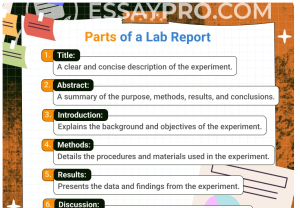Additional Parts of a Lab Report Discussion to Consider

Additional Parts of a Lab Report Discussion to Consider
The lab report doesn’t end with data and results. You can also add more layers—methodological reflections, theoretical integration, and personal insights—that extend your experiment’s reach:
Methodological Reflections: What alternative approaches could you have taken? Consider different paths that might yield new insights.
Theoretical Integration: How do your results align with or challenge existing theories? This is where your research converses with broader scientific ideas.
Ethical Considerations: What are the broader consequences of your findings? Reflect on their potential influence on policies and practices.
Personal Insights: Share unexpected lessons and discoveries encountered along your research journey, adding unique depth to your narrative.
How to Write a Discussion for a Lab Report?
Writing the discussion for a lab report is your opportunity to evaluate whether your results support your hypothesis or if they’ve taken you in a different direction. It’s all about explaining why things turned out the way they did and how they fit into the larger context of your field.
By the end, you’ll give your professor a clear understanding of what your results mean and why they matter.
Let’s go through the lap report format to make sure your discussion is as clear and insightful as possible.
Step 1: Summarize Your Key Findings
Start your lab discussion by laying out the main results of your experiment, focusing on what really matters to your hypothesis.
Let’s say your project was testing out a new AI program to improve online learning. Here’s how you can break it down:
Main Results: Start with something straightforward, like, “Our experiment showed that students using the AI learning platform had a 15% improvement in their test scores compared to those using a traditional e-learning system.” This gives a clear picture of the outcome.
How You Measured Results: Explain how you tracked progress—like the time students spent on activities, their completion rates, and quiz scores. This adds context to your findings.
Experiment Setup: How long did your study last? Who participated in it? What types of courses were involved? This helps your professor (and other readers) understand the scope of your results.
Step 2: Interpret the Results
After you’ve summarized the key findings in your discussion lab report, it’s time to interpret what they mean. This is where you explore the “why” behind the data.
Ask yourself, why did the AI program boost the test scores by 15%? Is it because it offered personalized feedback that traditional methods didn’t? Or could it be that the AI made learning more interactive, keeping students focused longer?
Think about these possibilities and how your results support or contradict existing theories or studies in the field.
An extra tip: If something unexpected happened—like the AI increased engagement but didn’t improve scores as much as expected—explore why that might be. Perhaps the tool worked better for some students than others.
Step 3: Compare with Existing Literature
Once you’ve interpreted your results, it’s important to see how they line up with what others have found in the field.
Contextualize Your Results: Start by placing your findings in context. For example, if your AI program improved test scores by 15%, check out what similar studies have reported. This helps you understand where your results fit within the broader research landscape.
Compare Results: See how your findings compare. If previous studies only saw a 10% improvement, your results suggest that the new AI program might be more effective. If your results are quite different, think about why that might be. Did you use a different approach or have unique study conditions?
Highlight Contributions: Talk about how your findings add to what’s already known. Do your results back up or challenge existing theories? By comparing your work to other research, you’re showing how your study contributes to the bigger picture.
This step helps you place your findings in context and shows that your work adds something valuable to the field.
Step 4: Discuss Potential Limitations
Is there something that went wrong? Something else that you wish you had included?
It’s fine, no experiment is flawless, and it’s important to be upfront about any limitations in your study when writing a discussion lab report. This just shows that you understand the scope of your work and where there might be room for improvement.
If your study on the AI program for online learning was conducted with a relatively small group of students, mention that. A small sample size might mean your results aren’t as widely applicable as you’d like. Similarly, if the study was short-term, it might not capture long-term effects.
Discussing these limitations doesn’t weaken your findings—it actually strengthens your discussion. It shows that you’re aware of the study’s boundaries and where further research might be needed.
Speaking of…
Step 5: Suggest Future Research
The final step in your discussion is to think ahead and suggest areas for future research. This is your chance to point out where your study could be expanded or where new questions might arise. Let’s take a look at the findings we discussed before:
Limitations: If your AI program improved test scores but had some limitations, like a small sample size or short duration, it’s worth suggesting that future research could involve a bigger, longer study. This would help confirm your findings and give more solid data.
Surprise findings: If you noticed that the AI tool seemed to work better for some students than others, future research could dig into why that happened. There might be a chance to tweak the program to make it work better for a wider range of students.
Opportunities: You could also suggest testing the AI program in different settings or with other subjects to see how it holds up. This could give more insights and help improve the technology.
By suggesting these future research areas, you’re helping to push the field forward and guiding where future studies might go.
Source:
